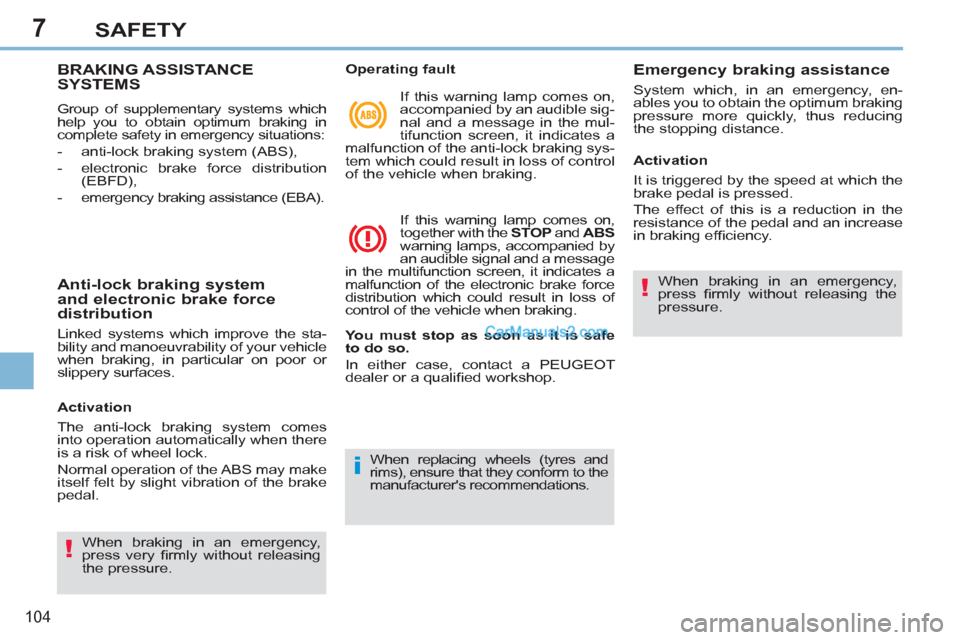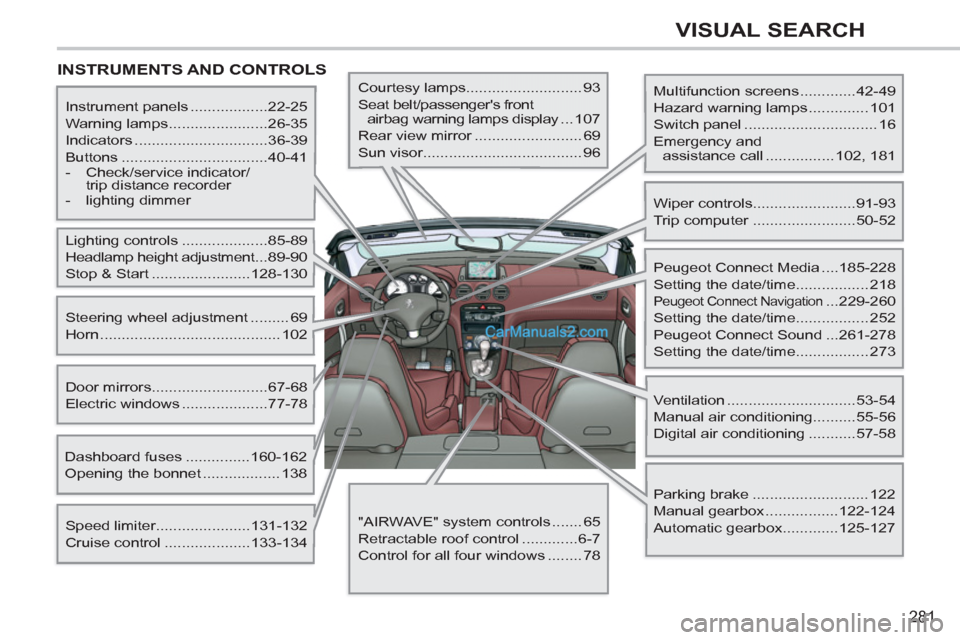2011 Peugeot 308 CC brake light
[x] Cancel search: brake lightPage 11 of 292

9
FAMILIARISATION
1.
Cruise control/speed limiter switches.
2.
Steering wheel adjustment control.
3.
Lighting and direction indicator
control stalk.
4.
Instrument panel.
5.
Driver's airbag.
Horn.
6.
Gear lever.
7.
Parking brake.
8.
12 V accessory socket.
9.
Heated seat control.
10.
Door mirror controls.
Electric window controls.
11 .
Bonnet release.
12.
Fusebox.
13.
Manual headlamp height
adjustment.
Stop & Start button.
14.
Side adjustable air vent.
15.
Front side window demisting vent.
16.
Speaker (tweeter).
17.
Windscreen demisting vent.
INSTRUMENTS AND CONTROLS
Page 22 of 292

20
ECO-DRIVING
Eco-driving is a range of everyday practices that allow the motorist to optimise their fuel consumption and CO2 emissions.
Optimise the use of your
gearbox
With a manual gearbox, move off gen-
tly, change up without waiting and
drive by changing up quite soon. If
your vehicle has the system, the gear
shift indicator invites you to change up;
it is displayed in the instrument panel,
follow its instructions.
With an automatic or electronic gear-
box, stay in Drive "D"
or Auto "A"
,
according to the type of gear selector,
without pressing the accelerator pedal
heavily or suddenly.
Drive smoothly
Maintain a safe distance between vehi-
cles, use engine braking rather than the
brake pedal, and press the accelerator
progressively. These attitudes contribute
towards a reduction in fuel consumption
and CO
2 emissions and also helps re-
duce the background traffi c noise.
When the traffi c is fl owing well, and if
you have cruise control, make use of
the system at speeds above 25 mph
(40 km/h).
Control the use of your
electrical equipment
Before moving off, if the passenger
compartment is too warm, ventilate it by
opening the windows and air vents be-
fore using the air conditioning.
Above 30 mph (50 km/h), close the win-
dows and leave the air vents open.
Remember to make use of equipment
that can help keep the temperature in
the passenger compartment down (sun
roof and window blinds...).
Switch off the air conditioning, unless
it has automatic digital regulation, as
soon as the desired temperature is at-
tained.
Switch off the demisting and defrosting
controls, if not automatic.
Switch off the heated seat as soon as
possible.
Switch off the headlamps and front
foglamps when the level of light does
not require their use.
Avoid running the engine before moving
off, particularly in winter; your vehicle will
warm up much faster while driving.
As a passenger, if you avoid connecting
your multimedia devices (fi lm, music, vid-
eo game...), you will contribute towards
limiting the consumption of electrical en-
ergy, and so of fuel.
Disconnect your portable devices be-
fore leaving the vehicle.
Page 106 of 292

7
!
i
!
104
SAFETY
BRAKING ASSISTANCE
SYSTEMS
Group of supplementary systems which
help you to obtain optimum braking in
complete safety in emergency situations:
- anti-lock braking system (ABS),
- electronic brake force distribution
(EBFD),
- emergency braking assistance (EBA).
Anti-lock braking system
and electronic brake force
distribution
Linked systems which improve the sta-
bility and manoeuvrability of your vehicle
when braking, in particular on poor or
slippery surfaces.
When braking in an emergency,
press very fi rmly without releasing
the pressure.
When replacing wheels (tyres and
rims), ensure that they conform to the
manufacturer's recommendations.
Operating fault
If this warning lamp comes on,
accompanied by an audible sig-
nal and a message in the mul-
tifunction screen, it indicates a
malfunction of the anti-lock braking sys-
tem which could result in loss of control
of the vehicle when braking.
If this warning lamp comes on,
together with the STOP
and ABS
warning lamps, accompanied by
an audible signal and a message
in the multifunction screen, it indicates a
malfunction of the electronic brake force
distribution which could result in loss of
control of the vehicle when braking.
Emergency braking assistance
System which, in an emergency, en-
ables you to obtain the optimum braking
pressure more quickly, thus reducing
the stopping distance.
Activation
The anti-lock braking system comes
into operation automatically when there
is a risk of wheel lock.
Normal operation of the ABS may make
itself felt by slight vibration of the brake
pedal.
Activation
It is triggered by the speed at which the
brake pedal is pressed.
The effect of this is a reduction in the
resistance of the pedal and an increase
in braking effi ciency.
When braking in an emergency,
press fi rmly without releasing the
pressure.
You must stop as soon as it is safe
to do so.
In either case, contact a PEUGEOT
dealer or a qualifi ed workshop.
Page 163 of 292

10
161
PRACTICAL INFORMATION
Dashboard fuses
The fusebox is placed in the lower dash-
board (left-hand side).
Access to the fuses
�)
refer to the paragraph "Access to
tooling".
Fuse tables
Fuse N°
Rating
Functions
F1
-
Not used.
F2
30 A
Earth for locking and deadlocking.
F3
5 A
Airbags and pretensioners control unit.
F4
10 A
Clutch pedal and dual-function brake switches,
electrochromatic rear view mirror, air conditioning,
steering wheel angle sensor, automatic gearbox,
switching and protection unit.
F5
30 A
Front one-touch electric windows, folding mirrors
supply.
F6
30 A
Rear one-touch electric windows, exterior door
opening controls.
F7
5 A
Front and rear courtesy lamps, map reading lamps,
sun visor lighting, glove box lighting.
F8
20 A
Audio equipment, radio/telephone, multifunction screen, tyre
under-infl ation detection, interior storage compartments.
F9
30 A
Front 12 V socket, cigarette lighter.
F10
15 A
Steering mounted controls, alarm siren, alarm
control unit.
F11
15 A
Low current ignition switch.
Page 177 of 292

12
175
TECHNICAL DATA
*
The weight of the braked trailer can be increased, within the GTW limit, on condition that the GVW of the towing vehicle is reduced
by the same amount; warning: towing with a lightly loaded towing vehicle may have an adverse effect on its road holding.
The GTW and towed load values indicated apply up to a maximum altitude of 1 000 metres; the towed load mentioned must
be reduced by 10 % for every additional 1 000 metres.
The speed of a towing vehicle must not exceed 60 mph (100 km/h) (comply with the legislation in force in your country).
High ambient temperatures may result in a reduction in the performance of the vehicle to protect the engine; when the ambi-
ent temperature is higher than 37 °C, limit the towed weight.
WEIGHTS AND TOWED LOADS (in kg)
Petrol engines
1.6 litre VTi
1.6 litre THP
1.6 litre THP
1.6 litre THP
120 hp
156 hp
150 hp
163 hp
200 hp
Gearboxes
Manual
Manual
Automatic
Automatic
Manual
Model codes: 4B...
5FS-0
5FV-8
5FV-A
5FE-J
5FM-J
5FU-8
- Unladen weight
1 480
1 515
1 530
1 540
1 540
1 535
- Kerb weight
1 555
1 590
1 605
1 615
1 615
1 610
- Gross vehicle weight (GVW)
1 885
1 940
1 970
1 970
1 970
1 984
- Gross train weight (GTW)
on a 12 % gradient
2 985
3 340
3 240
2 770
2 770
2 784
- Braked trailer (within GTW limit)
on a 10 % or 12 % gradient
1 100
1 400
1 270
800
800
800
- Braked trailer * (with load transfer
within GTW limit)
1 200
1 400
1 270
800
800
800
- Unbraked trailer
750
750
750
750
750
750
- Recommended nose weight
64
64
64
64
64
64
Page 179 of 292

12
177
TECHNICAL DATA
*
The weight of the braked trailer can be increased, within the GTW limit, on condition that the GVW of the towing vehicle is reduced by
the same amount; warning: towing with a lightly loaded towing vehicle may have an adverse effect on its road holding.
WEIGHTS AND TOWED LOADS (in kg)
Diesel engines
1.6 litre e-HDi PEF
112 hp
2.0 litre HDi PEF
163 hp
Gearboxes
Manual
Manual
Automatic
Model codes: 4B...
9HR-8/S
RHH-8
RHH-A
- Unladen weight
1 535
1 577
1 625
- Kerb weight
1 610
1 652
1 700
- Gross vehicle weight (GVW)
1 950
2 025
2 050
- Gross train weight (GTW)
on a 12 % gradient
3 050
3 525
3 550
- Braked trailer (within GTW limit)
n a 10 % or 12 % gradient
1 100
1 500
1 500
- Braked trailer * (with load transfer
within GTW limit)
1 200
1 500
1 500
- Unbraked trailer
750
750
750
- Recommended nose weight
64
64
64
The GTW and towed load values indicated apply up to a maximum altitude of 1 000 metres; the towed load mentioned must
be reduced by 10 % for every additional 1 000 metres.
The speed of a towing vehicle must not exceed 60 mph (100 km/h) (comply with the legislation in force in your country).
High ambient temperatures may result in a reduction in the performance of the vehicle to protect the engine; when the ambi-
ent temperature is higher than 37 °C, limit the towed weight.
Page 281 of 292

279
VISUAL SEARCH
EXTERIOR
Boot ...................................... 80, 82
Temporary tyre repair kit ....146-150
Changing a wheel ..............151-154
- tools
- removing/refi tting
Changing bulbs..................158-159
- rear lamps
- 3rd brake lamp
- number plate lamps
Parking sensors .................135-136
Towbar ...................................... 171
Towing ...............................169-170
Remote control key................70-74
- opening/closing
- unlocking/partial opening of the
boot
- anti-theft protection
- starting
- battery
Accessories .......................172-173
Retractable roof .........................6-7
Fuel tank ................................83-84
Door mirrors ...........................67-68
Side spotlamps ................... 89, 157
Doors .....................................79-81
- opening/closing
- central locking
- emergency locking
Alarm .....................................75-76
Electric windows ....................77-78
Lighting controls ....................85-89
Directional lighting ...................... 90
Headlamp height adjustment....89-90
Changing bulbs..................155-157
- front lamps
- foglamps
- direction indicator repeaters
Braking assistance ................... 104
Trajectory control ...................... 105
Tyre under-inflation detection ... 103
Tyre pressures .................. 150, 179
Page 283 of 292

281
VISUAL SEARCH
INSTRUMENTS AND CONTROLS
Multifunction screens .............42-49
Hazard warning lamps .............. 101
Switch panel ............................... 16
Emergency and
assistance call ................ 102, 181
Instrument panels ..................22-25
Warning lamps .......................26-35
Indicators ...............................36-39
Buttons ..................................40-41
- Check/service indicator/
trip distance recorder
- lighting dimmer
Lighting controls ....................85-89
Headlamp height adjustment ...89-90
Stop & Start .......................128-130
Speed limiter......................131-132
Cruise control ....................133-134
Door mirrors ...........................67-68
Electric windows ....................77-78
Dashboard fuses ...............160-162
Opening the bonnet .................. 138
Steering wheel adjustment ......... 69
Horn .......................................... 102
Courtesy lamps........................... 93
Seat belt/passenger's front
airbag warning lamps display ...107
Rear view mirror ......................... 69
Sun visor..................................... 96
Wiper controls........................91-93
Trip computer ........................50-52
Peugeot Connect Media ....185-228
Setting the date/time................. 218
Peugeot Connect Navigation ...229-260
Setting the date/time................. 252
Peugeot Connect Sound ...261-278
Setting the date/time................. 273
Ventilation ..............................53-54
Manual air conditioning..........55-56
Digital air conditioning ...........57-58
Parking brake ........................... 122
Manual gearbox .................122-124
Automatic gearbox.............125-127
"AIRWAVE" system controls ....... 65
Retractable roof control .............6-7
Control for all four windows ........ 78